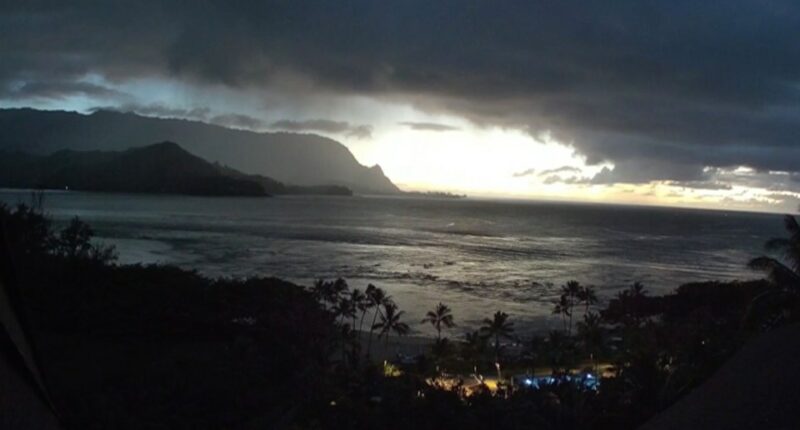Share this @internewscast.com
HAUNTING footage shows the moment ocean water receded along a Hawaii shoreline before the first tsunami wave crashed into the coast.
Around 7:20 pm on Tuesday, local time, observers noticed the sea receding just as the first wave struck the island, prompting residents to flee their homes.
Tsunami waves impacted Hawaii following an enormous 8.8 magnitude earthquake originating near Russia’s Far East on the Pacific Ring of Fire on Wednesday, one of the most powerful tremors on record.
The resulting waves reached Hawaii, Japan, California, and Washington, causing several injuries during the frantic attempts to reach safety, though none were severe.
A time-lapse video capturing sunset at Hanalei Bay, Kauai, illustrates the water retracting from the shore, set against looming clouds, as reported by Hawaii News Now.
Shortly after the unsettling video was captured, waves up to 3.9 feet tall charged toward the coastline, with security cameras at Hanalei Colony Resort also capturing the intense activity.
Water recedes right before a tsunami when the lowest part of the tsunami wave reaches the coast first.
Hawaii was braced for the most severe impact from the quake as millions moved out of the way of the water’s potential path.
Hawaii Governor Josh Green warned residents to seek higher ground in the face of the expected waves.
Evacuation protocols were put in place quickly, and most coastal zones were cleared by 6:30.
However, Hawaii’s alert level was downgraded to a tsunami advisory just before 11 pm, according to the National Weather Service.
The evacuation orders were lifted on the Big Island and Oahu, allowing people to return to their homes.
But the advisory means there could still be dangerous waves and some flooding on beaches or harbors.
Dave Snider, a tsunami warning coordinator at the National Tsunami Warning Center in Alaska, noted that the severe weather’s impact might persist for more than a day, according to the Associated Press.
“A tsunami is not just one wave,” Snider said.
“It’s a series of powerful waves over a long period of time. Tsunamis cross the ocean at hundreds of miles an hour — as fast as a jet airplane — in deep water.
“But when they get close to the shore, they slow down and start to pile up. And that’s where that inundation problem becomes a little bit more possible there.”
What causes tsunamis?
Here are the facts…
- Tsunami is a Japanese word used to describe huge waves – generally on oceans, but sometimes in lakes or large rivers
- Ocean tsunamis are caused by sudden motions, which displace a large amount of water
- This is typically an earthquake, but it could also be a volcanic eruption or underwater landslide
- A huge impact into water – like a large landslide or meteor – can also cause tsunamis
- When an earthquake happens, huge tectonic plates crunch together
- When the “snap” eventually happens, this gives a large shove to water
- This creates a tsunami that travels very quickly across the open oceans
- As the ocean becomes shallower, the tsunami wave is forced upwards
- This means tsunami waves typically grow very quickly in height (and slow down) as they approach the shallow shorelines near land
- Tsunamis are typically a series of waves, rather than one single wave
- As they approach land, these waves get closer together
- One of the best ways to spot an incoming tsunami is a sudden retreat of coastal water
- If the tide goes out very quickly, it’s a telling sign that something is wrong
- What you’re actually seeing is the trough of the incoming tsunami wave – on a huge scale
- The initial tsunami impact can be deadly
- But tsunami flooding is also highly dangerous to life, damaging buildings, destroying infrastructure, spreading waste and disease, and drowning people
Travelers heading to Hawaii have been stuck at airports as flights were paused to prepare for the monster waves coming to the island.
On Wednesday morning, tsunami activity continued in California, with waves reaching heights over 3 feet tall as tourists and locals in San Francisco and Los Angeles remained on high alert.
However, the highest tsunami waves were recorded in sections of the Kamchatka coast, where the earthquake struck, according to Russia’s Oceanology Institute.
The mega quake struck about 84 miles off the coast at a shallow depth of 12 miles.
The earthquake was the sixth largest ever recorded.
Nearly 2 million people were told to evacuate in Japan and Russia’s Kuril Islands in the Pacific.
Hours after the shock, four giant whales washed up on a Japanese beach.




















